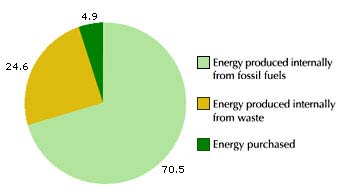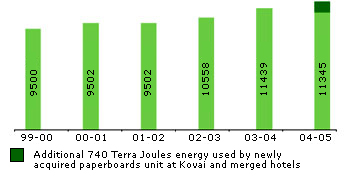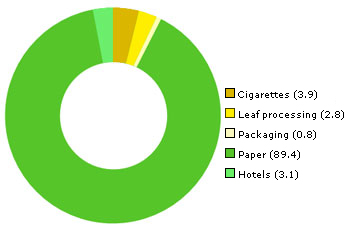| Global Warming refers to an average increase in
the earth’s temperature, which in turn causes adverse changes in climate. Climate
change may lead to changes in rainfall patterns, a rise in sea level, and a wide range of
impact on plants, wildlife and humans. Scientists are concerned about global warming
caused by human activities. Greenhouse gases trap energy in the atmosphere and thereby
make the earth warmer. Reduction of greenhouse gases discharged into the atmosphere is the
answer to the challenge of global warming. ITC’s strategy on energy sustainability
and its contribution in reducing global warming can be summarised as follows:
 Ensuring
availability and sustainability of energy supply Ensuring
availability and sustainability of energy supply
 Benchmarking
specific energy consumption to progressively achieve reduction Benchmarking
specific energy consumption to progressively achieve reduction
 Using renewable
sources, including energy from wastes Using renewable
sources, including energy from wastes
 Creating a
positive environmental footprint through sequestration Creating a
positive environmental footprint through sequestration
|
|
Energy Supply & Sustainability |
ITC operations consumed 12,085 Terra Joules of energy in 2004-05 (11,439 Terra Joules
in 03-04). 95.11% of this energy was generated internally. Almost a quarter (24.6%) of the
total energy was produced from wastes. Only 4.89% energy was purchased in the form of
electricity.
Energy Scenario in ITC (in percentage)

On a like to like basis, for the operating units reported in the
Sustainability Report 2004, actual consumption of energy has in fact gone down by 0.82%
from 03-04, in spite of a 9.4% growth in paper production, which is an energy-intensive
process.
Energy Consumption by ITC Units (Terra Joules)

|
 |
|
Benchmarked Specific Energy
Consumption |
The Bhadrachalam, Tribeni and Kovai units of the Paperboards and Specialty Papers
Division together account for over 89% of the total energy utilised by ITC operations.
Energy Consumption by ITC businesses (in percentage)

Significant efforts, therefore, continue to be directed towards minimising specific
energy consumption, a measure of energy requirement per unit of production, in these paper
and paperboards units.
Bhadrachalam
Energy consumption per tonne of paperboard in the Bhadrachalam unit decreased to 33.3
GJ (an improvement of 7.75% over the previous year). The specific energy consumption in
the last three years has been slightly higher than the lowest consumption figures achieved
in 00-01, due to the commissioning of two new paper machines and a substantially larger
pulp mill. |